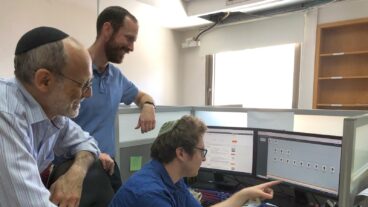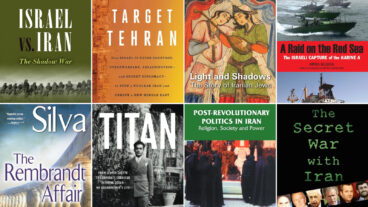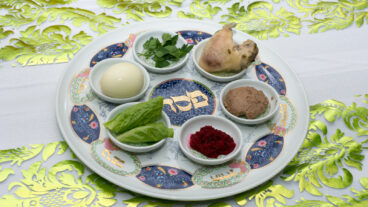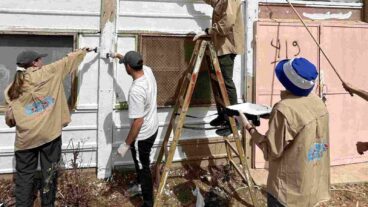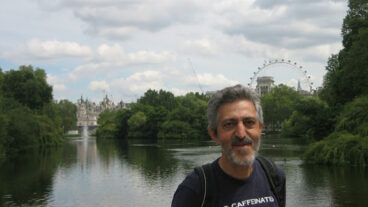It’s no secret that although Jerusalem has been reunited for 40 years, Israel’s capital is still, for most of its residents, a divided city where Jews and Arabs don’t mix. That’s what makes the scene at the two campuses of the Hebrew University of Jerusalem so eye-opening.
There, both at its Givat Ram campus and its main campus at Mount Scopus in the north of the city, is where Jewish and Arab students can be found, mingling freely in the classroom, cafeteria, and other common areas on campus, often encountering each other for the first time.
“We go out together. We cook together, we eat together, and we smoke together. We are all friends,” said Vera Bimbad, a second year English and linguistics student who lives together in an HU dorm of mixed Jewish and Arab students.
While everyday interactions between the students is not always as idyllic as Bimbaud’s experience, and for the most part the Arab and Jewish students on campus tend to remain among themselves, HU can boast of a long history of promoting cooperation and coexistence between Jews and Arabs.
Conceived by the Zionist movement in the late nineteenth century to be the “University of the Jewish People,” HU opened on Mount Scopus in East Jerusalem in 1925. Despite that moniker, the founders of the university envisioned it to be a place of coexistence between Arabs and Jews. Judah Magnes, the first chancellor of the university, and distinguished professors such as the theologian Martin Buber and Gershom Scholem were influential founders of Brit Shalom, which advocated equality between Jews and Arabs during the pre-state period.
“The founding fathers of the university had this liberal outlook. This is the tradition that they brought with them and we try to keep it,” explained Professor Esther Shohami, the dean of students at HU.
More than 24,000 students are enrolled at HU, including 12,000 undergraduates. In 2002, Professor Menachem Magidor, the president of the university, estimated that approximately 90 percent of the students at the university are Jewish and 10 percent are Arab. However, notes Shohami, “When they register to the university, there is no box to see if they are Arab or Jewish.” Unlike the United States, in order to ensure that there is no discrimination in admissions, it is against Israeli law to ask students what their ethnicity is.
One reason why students choose HU is the high quality of education at the institution – regarded as Israel’s best university.
“Studying abroad was never an option, because, let’s face it, the quality of the universities here are far more advanced,” stated Hanadi Rohana, a Christian Arab student of English and psychology.
According to HU officials, Arab students most frequently choose to study practical subjects which are almost guaranteed to lead to a high level of economic success. “To go to university is a tool to succeed in life,” stated Bakria Mawasi, a first year communications student.
“A high proportion of Arab students study in the pharmacy and medicine schools,” added HU’s Shohami.
For many of both the Jewish and Arab students, the beginning of their higher education also marked their first encounters with each other. According to the assistant dean of students, Noga Zimring, they quickly learn to put aside pre-conceived notions and learn mutual respect. And sometimes even more.
“When people, especially young people study together, and live together, they become friends,” she told ISRAEL21c.
For the students that live in the dormitories, cooperation and collaboration naturally occurs. “First we were just cooking together,” said Bimbad, an immigrant from the former Soviet Union. “Then this year I met a really nice girl and we just opened up. We were one door next to each other, so we see each other a lot. We help each other – food, money, studying.”
Perhaps knowing that this may be their best opportunity to truly work and cooperate together, some students eagerly explore opportunities to interact. Shohami explained that several law school students approached her in order to create study and discussion groups called kiruv levavot, or ‘bringing hearts together’ to bring Jewish and Arab students together. ‘Without Borders’, a university-initiated program to nudge the two sides together, engages the students in community, while another initiative called ‘Coffee Break’ provides the opportunity for Jewish and Arab students to sit between classes and socialize over coffee.
“If you know each other, you’re more likely to coexist,” Shohami said.
It’s a thought echoed by Mawasi, a Muslim student involved in another dialogue program, “Without understanding, we cannot coexist.”
For many Arab students, HU is their first experience studying and writing papers in Hebrew. While a challenge, the university is committed to ensuring that admitted students are not penalized due to their lack of Hebrew and they are provided access to intensive Hebrew-language instruction (ulpan) and additional resources.
Shohami noted that students whose native language is not Hebrew “are entitled to have extra time in exams the first year. In the university code it says that if your mother tongue is not Hebrew, in the first year that you are in the university you may have extra time to take the exam regardless if you are a new immigrant from Argentina, Russia or Arab from a village if your studies were not in Hebrew.”
One place in which Jewish and Arab students often interact is in ulpan, intensive Hebrew level classes. Particularly during the summer, new students who are not fluent in Hebrew – some Arab students, immigrants, and international students – often study together in their new language.
Leora Bereskin, a Canadian student, spent her junior year abroad in 2004. She describes her experience learning Hebrew with Arab students as “fantastic.”
“One of the best parts of the ulpan is that they bring together people from completely different backgrounds and cultures and force us to interact. Watching the news in Canada, of the latest suicide bombing in Tel Aviv or the military raids in Gaza, gives us a completely warped perspective about Palestinians and Israelis. It was only by meeting the Arab students in my class that I got to know them as people,” she told ISRAEL21c.
And it wasn’t just about politics, Bereskin added, pointing out that she even got “some great advice on hair-care from one girl who kept hers hidden under a burka but knew a lot about how to prevent frizz!”
Despite these successful examples of coexistence, challenges remain, especially when issues like personal and national identity emerge. Some students, whether they’re Jewish or Arab, prefer to focus on building their own identity.
“College years are a time when people are still searching for their identity,” said Michelle Shain, a first-year graduate student. “Identity is a big deal for university students. People are thinking about what it means to be an Israeli Arab or Israeli Jew.”
And, at times, the peaceful environment has been shattered by violence and terror. On July 31, 2002, at the height of the second intifada, an Arab construction worker from Jerusalem planted a bomb in the cafeteria on Mount Scopus where Jewish and Arab students were sitting, murdering nine people.
The attack had the potential to destroy the relationship built between students. Peter Willner, the then-executive vice president of the American Friends of Hebrew University told JTA immediately after the attack: “Hebrew University has been the last island of sanity in Jerusalem with respect to Arab and Jewish coexistence.”
Shain, who spent that year at HU as part of her junior year abroad program through Brandeis University, recalls the post-bombing atmosphere as tense.
“I’m not sure you can attribute it to the bombing itself, we were in the middle of a difficult political situation, there were a lot of bombings,” she said, adding that the tension was temporary.
Having subsequently made aliya and now studying at HU again as a graduate student in Contemporary Jewry, Shain says things have returned to the pre-bombing atmosphere on campus.
“Time has passed and the political situation is calmer,” she said.
In fact, events taking place in the rest of the country or in the region usually have little or no bearing on the HU campus, a phenomenon that one student attributes to its tolerant environment.
“I think there is much less hostility than the rest of the country because this is a place of academics, and people come to learn,” said Avigail Shapira, a third-year student in geography. “Both sides know that they each have come to learn. It’s just a kind of mutual respect.”
According to Shain, however, the key to HU’s coexistence success is its refusal to allow its students to remain isolated from each other. While in the rest of the country, it’s all too easy to block out the other side from your life, HU students live and breathe it every day.
“Students are forced to work together,” said Shain. “They are less isolated than the rest of the population in the city.”
And as Jerusalem celebrates 40 years of its reunification, it can look to Hebrew University as one of the shining examples of what the city can become in the next 40 years.




